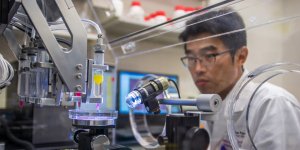Science News

Sea ice is like a closed window for the ocean. »

Researchers have discovered that DNA from the mitochondria acts as a danger signal in the body and triggers (...) »

A study has found that cuttlefish can pass a fishy version of the ‘marshmallow test’ – and those that can delay gratification the longest are the most intelligent. »

Researchers have analysed decades’ worth of data on the impact of repeated fires on ecosystems across the world. »

Researchers develop a system to identify drugs that might be repurposed to fight the coronavirus. »

Water treatment has the potential to remove nearly all viruses from drinking water. »

A computer network closely modelled on part of the human brain is enabling new insights into the way our brains process moving images - and explains some perplexing optical illusions. »

New framework for understanding super-Earths’ interiors prerequisite for assessing habitability potential. »

Scientists have used a technique to grow bile duct organoids – often referred to as ‘mini-organs’ (...) »

In the Mojave Desert, burrowing mammals are weathering hotter, drier conditions. »

An Agricultural Research Service entomologist has discovered the Nosema ceranae parasite that causes major problems and death in honey bees works by hijacking its host's iron for itself. »

What remains of the star that exploded just outside our galaxy in 1987? Debris has obscured scientists’ view, but two of NASA’s X-ray telescopes have revealed new clues. »

Revised temperature record affirms role of greenhouse gases in recent millennia. »

Scientists at the National Institutes of Health have used two different (...) »

One day 66 million years ago, Earth suddenly transformed from being a verdant, dinosaur-ridden world to a soot-covered apocalyptic hellscape. »

Scientists have identified a new phenomenon they describe as "interactive dreaming", where people experiencing deep sleep and lucid dreams are able to follow instructions, (...) »

Gliomas are common brain tumors that comprise about one third of all cancers of the nervous system. »

When most people hear "food contamination," they think of bacteria on unwashed fruits or vegetables or undercooked meat. However, there are other ways for harmful contaminants to get into food products. »

Restoring animal habitat requires much more than just the right plants. »

Hydrocarbons that trace their origin to biological sources may play a large role in ocean ecology. »

Chloroplast-fortified 3D-printer ink may strengthen products like custom sneaker soles. »

Quagga mussels' spread across 4 of the 5 Great Lakes has altered natural phosphorus exchange rates. »

Identification takes next step to making a widely available plant a source for energy. »

Global synthesis reveals bird traits that promote Lyme and flags high-risk species. »

Sourdough is an excellent model system for studying interactions between microbes. »

Researchers have developed a computerized adaptive screener to identify youth at risk for attempting suicide. »

When the Laki volcano erupted in 1783, its effects rippled around the world. »

New type of optical computing could solve highly complex problems that are out of reach for even the most powerful supercomputers. »

Research opens the door to applications in recycling and remediation. »

Team used deposits in the caves of the Mediterranean island of Mallorca. »

How the larvae of colorful clownfish that live among coral reefs in the Philippines are dispersed varies widely, depending on the year (...) »

Simple soil remediation can substantially reduce levels of the toxic metal lead in the blood of children living in heavily contaminated areas, says a new study conducted in Bangladesh. »

Entomologist Akito Kawahara's message is straightforward: We can't live without insects. (...) »

AI technique enables researchers to study data trends more quickly, improving prediction ability. »

Carrots, while in the ground, are home to a community of microorganisms, some members of which wage a kind of battle (...) »

A new study suggests acidic lakes may have harbored life in Earth’s ancient past. »

Hunt is on to find the lichen in the wild -- if it still exists. »

New study identifies genetic markers associated with female color pattern. »

Scientists with NASA’s Oceans Melting Greenland mission are probing (...) »

Study of simplest yet most toxic venom will help explain array of genetic questions. »

Scientists used copper foil, glass containers and a conventional household microwave oven. »

The vital role of ventilation in the spread of COVID-19 (...) »

Chemists have developed a nanomaterial they can trigger to shape-shift -- from flat sheets to tubes and back to sheets again -- in a controllable fashion. »

An invisible flow of groundwater seeps into the ocean along coastlines all over the world. »

Researchers from the University of Cambridge have discovered a fossil of the earliest starfish-like animal, which helps us understand the origins of the nimble-armed creature. »

Butterflies have evolved to produce a strongly scented chemical in their genitals, which they leave behind after sex to deter other males from pursuing their mates. »

Study indicates that energy can be extracted from black holes. »

By most accounts, 2020 has been a rough year for the planet. It was the warmest year on record, just barely exceeding the record set in 2016 by less than a tenth of a degree according to NASA’s analysis. »

People on a low-fat, plant-based diet ate fewer daily calories but had higher insulin and blood glucose levels, compared to when they ate a low-carbohydrate, animal-based diet. »

Mysterious wasting disease has nearly killed off sea star populations around the world. »


